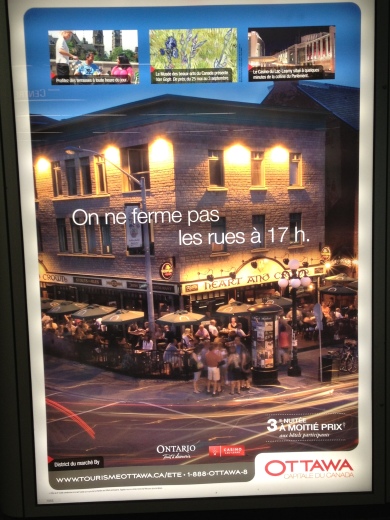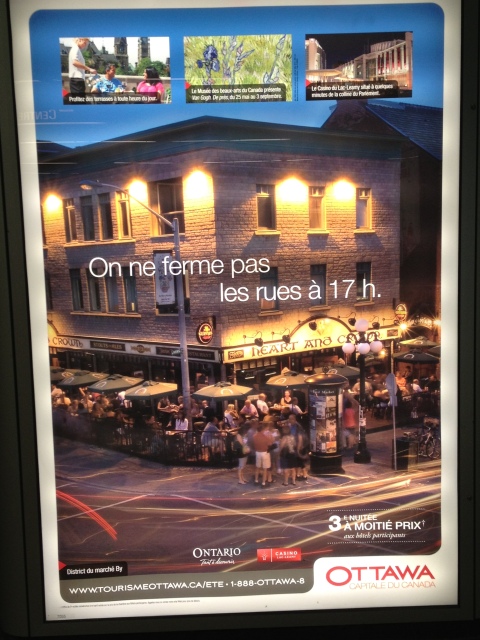By Gunter Soydanbay.
Recently, I’ve learned that 86% of place branding projects fail. While the research does not explain why, I am willing to bet that one of the major causes of failure is “thinking stereotypically instead of archetypically.” Case in point: Ottawa.
The above picture was taken in Montreal. It says: “We don’t shut down the streets at 5 PM.” This ad tells me two things:
- People from Montreal perceive Ottawa as a dull city.
- Ottawa thinks it can and should fix such a stereotype.
While it is good for Ottawa to acknowledge that it is perceived as a boring city, I don’t think it is a smart thing to try to un-do such a stereotype. Anyone in the communications business would know that changing perceptions is extremely difficult, slow and expensive. Stereotypes are built over time, and they are transferred from one generation to another. For instance, would you be surprised had you read such an imaginary stat: “Half of the Montrealers, who think Ottawa is boring, have never been to Ottawa in their lives.” (I made this one up.) Such is the power of the stereotype! That’s why instead of limiting themselves to stereotypes, places should discover their archetypes. Let’s start by defining the difference:
A stereotype is a widely held but fixed and oversimplified image or ideaof a particular type of person or thing. For instance, these are all stereotypes: French are arrogant, Turks are barbaric, and Germans are cold. Such beliefs are childish, simple and predominantly negative. You should not build your brand or campaign on such a primitive ground.
On the other hand, an archetype is a recurrent symbol or motif in literature, art, or mythology inherited from the earliest human ancestors, and supposed to be present in the collective unconscious. For instance, these are all archetypes: Michael Jordan is a warrior, Mother Teresa is a caregiver, and Ben and Jerry’s is an entertainer. An archetype is not a personality trait but a mythological storyline. Once you find your archetype, you know the compelling and the authentic story you should tell. Going back to the Ottawa’s case, here is what can be done:
About 5 years ago, the tourism bureau of Washington DC decided to rebrand their city in order to attract more tourists. A stereotypical image would be that DC is a governmental city, not a touristic one. But an archetypal image would be much richer. Research revealed that a trip to Washington DC meant powerful memories. When you visit DC, you experience the greatness of the city and feel empowered. The campaign invited visitors to create their own power trip. This is not a stereotype. This is a rich archetypal territory…

Today’s actionable tip: Know your stereotype, so that you can take steps to fix it. But also know that you are more than a stereotype. Start by asking why?



